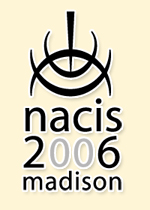
The North American Cartographic Information Society (NACIS) held its annual meeting in Salt Lake City from October 12-15, 2005. The conference was an opportunity for people from all corners of the cartographic community to meet, share their work, and exchange ideas. The annual meeting is an important way for NACIS to realize its mission of promoting cartographic understanding and innovation.
The conference presentations reflected the diversity of the NACIS membership. There were talks on designing print maps, map education, interfaces for computer mapping, maps in libraries, maps in political discourse, even a poetry reading with map-related themes. UW-Madison Professor Mark Harrower introduced MapShaper, a web-based service for generalizing map linework interactively. MapShaper is currently under development at www.mapshaper.org. UW-Madison Map and GIS Librarian Jaime Martindale and Greg Allord of the U.S. Geological Survey presented their topographic map digital preservation project, which aims to digitally archive all of the topographic maps printed by the USGS since 1879.
One of the highlights of the conference was a group critique and discussion of two recently published books by prominent cartographic educators: Designing Better Maps: A Guide for GIS Users by Cynthia Brewer and Making Maps: A Visual Guide to Map Design for GIS by John Krygier and Denis Wood. Both books provide accessible introductions to software-assisted map design, and both include many examples of successful and unsuccessful design. Their approaches to map design complement rather than repeat each other. Designing Better Maps distills much of the accumulated wisdom about effective design, while Making Maps adopts a flexible and sometimes irreverent attitude towards established practices.
The meeting culminated in a video presentation by map collector David Rumsey, who demonstrated how software for 3-D cartographic visualization could be used to display historical maps. Rumsey encouraged mapmakers to look to the past as a source of cartographic ideas that can be used today. He also spoke about the future of mapping and geovisualization, anticipating growth in the areas of popular GIS systems (e.g. Google Earth), web searching using spatial criteria, maps for portable devices, open content and open systems. In keeping with his commitment to provide free online access to his own collection (www.davidrumsey.com), Rumsey called on others to make maps and geospatial content available for free public use.
The 2006 meeting will be held from October 18-21 in Madison. Information regarding NACIS and the upcoming conference is available at www.nacis.org.
